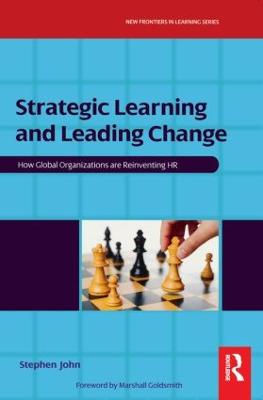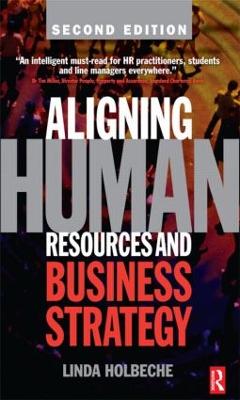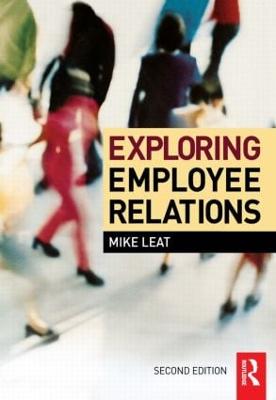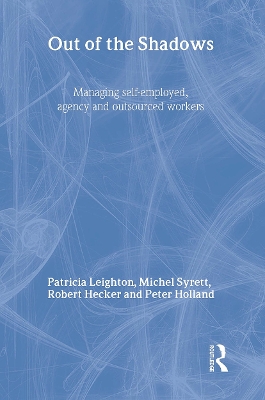Thriving in a Complex World
 -10%
portes grátis
-10%
portes grátis
Thriving in a Complex World
Garvey-Berger, Jennifer
Taylor & Francis Ltd
01/2050
300
Mole
Inglês
9780750679350
Pré-lançamento - envio 15 a 20 dias após a sua edição
Descrição não disponível.
Part 1: Foreword
Because this book attempts to span the theory/practice divide, I have requested (and feel confident I will get) two forewords for this book. The first will be by Robert Kegan, one of the leading theorists in the adult developmental world. The second will be by a leading HR professional (e.g., the Executive Vice President, Organization Effectiveness and Public Relations at Arbitron)
Part 2: Introduction
Chapter 1 will introduce the reader to the idea of adult development as an important thing to consider. Adult development has a funny resonance with people; on the one hand, they question the notion of adult development as true (people will often say, "You mean adolescent development?") and on the other hand, what we know about adult development goes very well with the way we tend to intuitively think about ideas such as maturity and wisdom. With quick case studies of two leaders whose developmental levels (and thus their actions) are quite different, this chapter will first offer readers a visceral experience with these developmental differences, and then it will unpack them in a quick primer about developmental orders. Readers will begin to recognize that they already have a developmental orientation, and they'll get a quick overview of the theory-with lots of examples-to help them see the pattern of development in this constructive-developmental theory. The case material will be brief and will be based in organizations (watching the way two different leaders deal with a difficult direct report, for example)-to illustrate the key concepts and not to delve into applications. This chapter is for folks who like to first view theories from 20,000 feet in the air.
Part 2: Four meaning-making worlds
Chapter 2 will enter the meaning-making world of the Prince/Princess Form, the lest complex meaning-making world of adulthood. Adults at this stage of development are oriented to their own perspectives, and cannot yet internalize the perspectives of others; their orientation is to those things which are specific to the here-and-now and not generalizable to other situations, places, etc. This means that people who see the world through these eyes are often misunderstood as selfish, self-centered, and slow, when they are really doing the best they can at this moment. This form is uncommon in the high levels of an organization, but more common in other places in the organization and quite common in jobs which don't require much education. This chapter will offer ways to recognize this order, see its many strengths and abilities, and also understand its key blindspots. Since those who manage others rarely see the world through these eyes, it is difficult for the manager to understand the motivation of the Prince/Princess. Because 25-50% of some adult populations make sense of the world in this way, it behoves those in organizations to understand the Prince/Princess and offer ways to help those at this place do good work and also grow. This chapter, with rich case examples of people looking at the Prince employee and also of the Prince employee talking about himself, will offer the reader new ways of understanding people who make sense of the world in this way as well as new tools for managing those at the Prince/Princess form.
Chapter 3 will enter the most common of the adult meaning-making worlds, the Journeyman form. Through the eyes of both those who are trying to make sense of the world as Journeymen and also those who work with Journeymen, this chapter will introduce the reader to this world in a robust and respectful way. Those at the Journeyman form are very tuned into the opinions and ideas of others, and cannot yet self-author opinions/theories/etc. about the world. This chapter will look at the strengths and the blindspots of Journeymen and will help others understand how to support them and how to offer them opportunities to grow. Because it is likely that some readers of this book will also be at this form, there will be a set of self-diagnostic questions for readers to consider, in addition to the questions they might bring to their thinking about those with whom they work.
Chapter 4 will enter the CEO form. This is the form that is most stereotypically thought of as what adulthood looks like (where people have an internal guide which helps them mediate among the perspectives and theories of others). This chapter will offer examples of CEOs-both from their perspective and the perspective of others. This chapter will cover the greatest trials of this order (which generally involve having to work with people who have a less complex view of the world-especially when those less complex people are in charge). It will also examine the strengths and blindspots of this order. Because many readers are likely making meaning at-or working to grow toward-this form, this chapter will offer diagnostic questions for the reader to ask herself and others. Finally, this chapter will offer ways CEOs can begin to expand their perspectives so that they can grow.
Chapter 5 will enter the most complex stage of adulthood that theorists have yet described, what I call the Elder form. Because I have been researching those at this highest form of development, I can offer a full description with rich case studies of Elders, instead of the hypothetically created descriptions that have come before. While there are likely to be few members of organizations at this form of mind (as, indeed, there are few people fully making meaning in this form in the world), it may well be that organizations will grow to need the strengths and wisdom of Elders more and more as time goes on. This chapter will consider the biggest challenge for people at this form-simply to live in a world where they have few companions who understand the world in such a complex way. It will also consider the benefits of the Elder to those in organizations-as well as the challenges of having such complex-thinkers in the organization.
Part 3: Applications to individuals and organizations
Chapter 6 will be directed to those who have one-on-one responsibilities with others to support, manage, guide, etc. One-on-one interventions can be specifically tailored to best understand the meaning-making of another person and help support and challenge that person in respectful and helpful ways. One of the greatest advantages of one-on-one work is the opportunity to really listen to the person with whom you are working (whether as a coach, a manager, or a direct report). By paying careful attention to the way the other person sees the world (by, for example, listening for what she feels responsible for and which things she blames others for), you can get a clear picture of the world he sees in the way that he sees it. Thus, your interventions with him can be honed to the way he sees the world, offering a far greater chance for success than if your interventions are geared towards the way you see the world. This chapter will have a section for listening to the meaning of your direct report, your boss, or your client. There will be case examples throughout as well as specific questions you might ask and specific ways of thinking about your approach. (While this chapter will be helpful to managers and others who deal with adults one-on-one, there will also be a section dedicated specifically to executive coaching.)
Chapter 7 will focus on the inevitable times when people of several different meaning-making worlds work together. Directed towards those who have to lead groups as managers or trainers, this chapter will offer tools and procedures for communicating to a group, listening for different forms of understanding in the group (and thus recognizing the different ways the message may have been heard), mediating conflict that arises from different forms of understanding, and motivating a group to work and learn together. Using case studies, guided questions, and clear explanations, this chapter aims to take the diversity of forms of understanding into account just as those in organizations have begun to consider other kinds of group diversity. This chapter will take seriously the implications of the colliding of different meaning-making worlds and suggest ways that people can learn to talk-and listen-across different worlds.
Chapter 8 will be focused on organization-level interventions and will introduce the concept of a "Developmental organization" that is structured to promote (and not limit) development of its employees. This chapter will look at common organizational practices (e.g., rewarding, promoting, teaming, etc.) and examine the way these practices can either support or inhibit the growth of forms of self-complexity in employees. Organization-wide initiatives will be the core focus of this chapter. I'll use case studies and descriptions of different professional development initiatives (leadership development, team building, TQM, etc.) to show the ways that professional development has the (generally-squandered) potential to develop new forms of mind throughout an organization.
Part 3: Future directions
Chapter 9 will offer both a caution and also a best-case scenario about developmentally-oriented professional development. In this chapter, I'll deal most explicitly with issues of ethics (although an orientation to the importance of ethical developmental work will, of course, be in every section) and to the power of developing a workforce with a greater capacity for understanding the increasingly complex world. This chapter will lay out the difficulties-and great benefits-of creating a Developmental Organization. With examples of work done in organizations and an examination of the possible results, this chapter makes a case that paying attention to each of the ways adults make meaning-throughout the organization-can help increase productivity and happiness.
Appendix A will provide additional information about adult development for those who want to know more background and theoretical information. This part of the appendix will argue that the idea of adult development is both ancient (in the sense of the wise ones in ancient societies) and also a current and growing field (in that the number of people working specifically on issues of adult development is greater now than it has ever been). This chapter will also explain some of the different ways folks have thought about adult development (e.g., life-stage theories of Erikson, individuation of Jung, etc.). Finally, it will argue that constructive-developmental theories of adult development are expansive and useful in thinking about adults because they deal with both the construction of meaning and also the development of that construction over time.
Also in the appendix, there will be some examples of useful handouts, case-study interventions, etc.
Because this book attempts to span the theory/practice divide, I have requested (and feel confident I will get) two forewords for this book. The first will be by Robert Kegan, one of the leading theorists in the adult developmental world. The second will be by a leading HR professional (e.g., the Executive Vice President, Organization Effectiveness and Public Relations at Arbitron)
Part 2: Introduction
Chapter 1 will introduce the reader to the idea of adult development as an important thing to consider. Adult development has a funny resonance with people; on the one hand, they question the notion of adult development as true (people will often say, "You mean adolescent development?") and on the other hand, what we know about adult development goes very well with the way we tend to intuitively think about ideas such as maturity and wisdom. With quick case studies of two leaders whose developmental levels (and thus their actions) are quite different, this chapter will first offer readers a visceral experience with these developmental differences, and then it will unpack them in a quick primer about developmental orders. Readers will begin to recognize that they already have a developmental orientation, and they'll get a quick overview of the theory-with lots of examples-to help them see the pattern of development in this constructive-developmental theory. The case material will be brief and will be based in organizations (watching the way two different leaders deal with a difficult direct report, for example)-to illustrate the key concepts and not to delve into applications. This chapter is for folks who like to first view theories from 20,000 feet in the air.
Part 2: Four meaning-making worlds
Chapter 2 will enter the meaning-making world of the Prince/Princess Form, the lest complex meaning-making world of adulthood. Adults at this stage of development are oriented to their own perspectives, and cannot yet internalize the perspectives of others; their orientation is to those things which are specific to the here-and-now and not generalizable to other situations, places, etc. This means that people who see the world through these eyes are often misunderstood as selfish, self-centered, and slow, when they are really doing the best they can at this moment. This form is uncommon in the high levels of an organization, but more common in other places in the organization and quite common in jobs which don't require much education. This chapter will offer ways to recognize this order, see its many strengths and abilities, and also understand its key blindspots. Since those who manage others rarely see the world through these eyes, it is difficult for the manager to understand the motivation of the Prince/Princess. Because 25-50% of some adult populations make sense of the world in this way, it behoves those in organizations to understand the Prince/Princess and offer ways to help those at this place do good work and also grow. This chapter, with rich case examples of people looking at the Prince employee and also of the Prince employee talking about himself, will offer the reader new ways of understanding people who make sense of the world in this way as well as new tools for managing those at the Prince/Princess form.
Chapter 3 will enter the most common of the adult meaning-making worlds, the Journeyman form. Through the eyes of both those who are trying to make sense of the world as Journeymen and also those who work with Journeymen, this chapter will introduce the reader to this world in a robust and respectful way. Those at the Journeyman form are very tuned into the opinions and ideas of others, and cannot yet self-author opinions/theories/etc. about the world. This chapter will look at the strengths and the blindspots of Journeymen and will help others understand how to support them and how to offer them opportunities to grow. Because it is likely that some readers of this book will also be at this form, there will be a set of self-diagnostic questions for readers to consider, in addition to the questions they might bring to their thinking about those with whom they work.
Chapter 4 will enter the CEO form. This is the form that is most stereotypically thought of as what adulthood looks like (where people have an internal guide which helps them mediate among the perspectives and theories of others). This chapter will offer examples of CEOs-both from their perspective and the perspective of others. This chapter will cover the greatest trials of this order (which generally involve having to work with people who have a less complex view of the world-especially when those less complex people are in charge). It will also examine the strengths and blindspots of this order. Because many readers are likely making meaning at-or working to grow toward-this form, this chapter will offer diagnostic questions for the reader to ask herself and others. Finally, this chapter will offer ways CEOs can begin to expand their perspectives so that they can grow.
Chapter 5 will enter the most complex stage of adulthood that theorists have yet described, what I call the Elder form. Because I have been researching those at this highest form of development, I can offer a full description with rich case studies of Elders, instead of the hypothetically created descriptions that have come before. While there are likely to be few members of organizations at this form of mind (as, indeed, there are few people fully making meaning in this form in the world), it may well be that organizations will grow to need the strengths and wisdom of Elders more and more as time goes on. This chapter will consider the biggest challenge for people at this form-simply to live in a world where they have few companions who understand the world in such a complex way. It will also consider the benefits of the Elder to those in organizations-as well as the challenges of having such complex-thinkers in the organization.
Part 3: Applications to individuals and organizations
Chapter 6 will be directed to those who have one-on-one responsibilities with others to support, manage, guide, etc. One-on-one interventions can be specifically tailored to best understand the meaning-making of another person and help support and challenge that person in respectful and helpful ways. One of the greatest advantages of one-on-one work is the opportunity to really listen to the person with whom you are working (whether as a coach, a manager, or a direct report). By paying careful attention to the way the other person sees the world (by, for example, listening for what she feels responsible for and which things she blames others for), you can get a clear picture of the world he sees in the way that he sees it. Thus, your interventions with him can be honed to the way he sees the world, offering a far greater chance for success than if your interventions are geared towards the way you see the world. This chapter will have a section for listening to the meaning of your direct report, your boss, or your client. There will be case examples throughout as well as specific questions you might ask and specific ways of thinking about your approach. (While this chapter will be helpful to managers and others who deal with adults one-on-one, there will also be a section dedicated specifically to executive coaching.)
Chapter 7 will focus on the inevitable times when people of several different meaning-making worlds work together. Directed towards those who have to lead groups as managers or trainers, this chapter will offer tools and procedures for communicating to a group, listening for different forms of understanding in the group (and thus recognizing the different ways the message may have been heard), mediating conflict that arises from different forms of understanding, and motivating a group to work and learn together. Using case studies, guided questions, and clear explanations, this chapter aims to take the diversity of forms of understanding into account just as those in organizations have begun to consider other kinds of group diversity. This chapter will take seriously the implications of the colliding of different meaning-making worlds and suggest ways that people can learn to talk-and listen-across different worlds.
Chapter 8 will be focused on organization-level interventions and will introduce the concept of a "Developmental organization" that is structured to promote (and not limit) development of its employees. This chapter will look at common organizational practices (e.g., rewarding, promoting, teaming, etc.) and examine the way these practices can either support or inhibit the growth of forms of self-complexity in employees. Organization-wide initiatives will be the core focus of this chapter. I'll use case studies and descriptions of different professional development initiatives (leadership development, team building, TQM, etc.) to show the ways that professional development has the (generally-squandered) potential to develop new forms of mind throughout an organization.
Part 3: Future directions
Chapter 9 will offer both a caution and also a best-case scenario about developmentally-oriented professional development. In this chapter, I'll deal most explicitly with issues of ethics (although an orientation to the importance of ethical developmental work will, of course, be in every section) and to the power of developing a workforce with a greater capacity for understanding the increasingly complex world. This chapter will lay out the difficulties-and great benefits-of creating a Developmental Organization. With examples of work done in organizations and an examination of the possible results, this chapter makes a case that paying attention to each of the ways adults make meaning-throughout the organization-can help increase productivity and happiness.
Appendix A will provide additional information about adult development for those who want to know more background and theoretical information. This part of the appendix will argue that the idea of adult development is both ancient (in the sense of the wise ones in ancient societies) and also a current and growing field (in that the number of people working specifically on issues of adult development is greater now than it has ever been). This chapter will also explain some of the different ways folks have thought about adult development (e.g., life-stage theories of Erikson, individuation of Jung, etc.). Finally, it will argue that constructive-developmental theories of adult development are expansive and useful in thinking about adults because they deal with both the construction of meaning and also the development of that construction over time.
Also in the appendix, there will be some examples of useful handouts, case-study interventions, etc.
Este título pertence ao(s) assunto(s) indicados(s). Para ver outros títulos clique no assunto desejado.
Part 1: Foreword
Because this book attempts to span the theory/practice divide, I have requested (and feel confident I will get) two forewords for this book. The first will be by Robert Kegan, one of the leading theorists in the adult developmental world. The second will be by a leading HR professional (e.g., the Executive Vice President, Organization Effectiveness and Public Relations at Arbitron)
Part 2: Introduction
Chapter 1 will introduce the reader to the idea of adult development as an important thing to consider. Adult development has a funny resonance with people; on the one hand, they question the notion of adult development as true (people will often say, "You mean adolescent development?") and on the other hand, what we know about adult development goes very well with the way we tend to intuitively think about ideas such as maturity and wisdom. With quick case studies of two leaders whose developmental levels (and thus their actions) are quite different, this chapter will first offer readers a visceral experience with these developmental differences, and then it will unpack them in a quick primer about developmental orders. Readers will begin to recognize that they already have a developmental orientation, and they'll get a quick overview of the theory-with lots of examples-to help them see the pattern of development in this constructive-developmental theory. The case material will be brief and will be based in organizations (watching the way two different leaders deal with a difficult direct report, for example)-to illustrate the key concepts and not to delve into applications. This chapter is for folks who like to first view theories from 20,000 feet in the air.
Part 2: Four meaning-making worlds
Chapter 2 will enter the meaning-making world of the Prince/Princess Form, the lest complex meaning-making world of adulthood. Adults at this stage of development are oriented to their own perspectives, and cannot yet internalize the perspectives of others; their orientation is to those things which are specific to the here-and-now and not generalizable to other situations, places, etc. This means that people who see the world through these eyes are often misunderstood as selfish, self-centered, and slow, when they are really doing the best they can at this moment. This form is uncommon in the high levels of an organization, but more common in other places in the organization and quite common in jobs which don't require much education. This chapter will offer ways to recognize this order, see its many strengths and abilities, and also understand its key blindspots. Since those who manage others rarely see the world through these eyes, it is difficult for the manager to understand the motivation of the Prince/Princess. Because 25-50% of some adult populations make sense of the world in this way, it behoves those in organizations to understand the Prince/Princess and offer ways to help those at this place do good work and also grow. This chapter, with rich case examples of people looking at the Prince employee and also of the Prince employee talking about himself, will offer the reader new ways of understanding people who make sense of the world in this way as well as new tools for managing those at the Prince/Princess form.
Chapter 3 will enter the most common of the adult meaning-making worlds, the Journeyman form. Through the eyes of both those who are trying to make sense of the world as Journeymen and also those who work with Journeymen, this chapter will introduce the reader to this world in a robust and respectful way. Those at the Journeyman form are very tuned into the opinions and ideas of others, and cannot yet self-author opinions/theories/etc. about the world. This chapter will look at the strengths and the blindspots of Journeymen and will help others understand how to support them and how to offer them opportunities to grow. Because it is likely that some readers of this book will also be at this form, there will be a set of self-diagnostic questions for readers to consider, in addition to the questions they might bring to their thinking about those with whom they work.
Chapter 4 will enter the CEO form. This is the form that is most stereotypically thought of as what adulthood looks like (where people have an internal guide which helps them mediate among the perspectives and theories of others). This chapter will offer examples of CEOs-both from their perspective and the perspective of others. This chapter will cover the greatest trials of this order (which generally involve having to work with people who have a less complex view of the world-especially when those less complex people are in charge). It will also examine the strengths and blindspots of this order. Because many readers are likely making meaning at-or working to grow toward-this form, this chapter will offer diagnostic questions for the reader to ask herself and others. Finally, this chapter will offer ways CEOs can begin to expand their perspectives so that they can grow.
Chapter 5 will enter the most complex stage of adulthood that theorists have yet described, what I call the Elder form. Because I have been researching those at this highest form of development, I can offer a full description with rich case studies of Elders, instead of the hypothetically created descriptions that have come before. While there are likely to be few members of organizations at this form of mind (as, indeed, there are few people fully making meaning in this form in the world), it may well be that organizations will grow to need the strengths and wisdom of Elders more and more as time goes on. This chapter will consider the biggest challenge for people at this form-simply to live in a world where they have few companions who understand the world in such a complex way. It will also consider the benefits of the Elder to those in organizations-as well as the challenges of having such complex-thinkers in the organization.
Part 3: Applications to individuals and organizations
Chapter 6 will be directed to those who have one-on-one responsibilities with others to support, manage, guide, etc. One-on-one interventions can be specifically tailored to best understand the meaning-making of another person and help support and challenge that person in respectful and helpful ways. One of the greatest advantages of one-on-one work is the opportunity to really listen to the person with whom you are working (whether as a coach, a manager, or a direct report). By paying careful attention to the way the other person sees the world (by, for example, listening for what she feels responsible for and which things she blames others for), you can get a clear picture of the world he sees in the way that he sees it. Thus, your interventions with him can be honed to the way he sees the world, offering a far greater chance for success than if your interventions are geared towards the way you see the world. This chapter will have a section for listening to the meaning of your direct report, your boss, or your client. There will be case examples throughout as well as specific questions you might ask and specific ways of thinking about your approach. (While this chapter will be helpful to managers and others who deal with adults one-on-one, there will also be a section dedicated specifically to executive coaching.)
Chapter 7 will focus on the inevitable times when people of several different meaning-making worlds work together. Directed towards those who have to lead groups as managers or trainers, this chapter will offer tools and procedures for communicating to a group, listening for different forms of understanding in the group (and thus recognizing the different ways the message may have been heard), mediating conflict that arises from different forms of understanding, and motivating a group to work and learn together. Using case studies, guided questions, and clear explanations, this chapter aims to take the diversity of forms of understanding into account just as those in organizations have begun to consider other kinds of group diversity. This chapter will take seriously the implications of the colliding of different meaning-making worlds and suggest ways that people can learn to talk-and listen-across different worlds.
Chapter 8 will be focused on organization-level interventions and will introduce the concept of a "Developmental organization" that is structured to promote (and not limit) development of its employees. This chapter will look at common organizational practices (e.g., rewarding, promoting, teaming, etc.) and examine the way these practices can either support or inhibit the growth of forms of self-complexity in employees. Organization-wide initiatives will be the core focus of this chapter. I'll use case studies and descriptions of different professional development initiatives (leadership development, team building, TQM, etc.) to show the ways that professional development has the (generally-squandered) potential to develop new forms of mind throughout an organization.
Part 3: Future directions
Chapter 9 will offer both a caution and also a best-case scenario about developmentally-oriented professional development. In this chapter, I'll deal most explicitly with issues of ethics (although an orientation to the importance of ethical developmental work will, of course, be in every section) and to the power of developing a workforce with a greater capacity for understanding the increasingly complex world. This chapter will lay out the difficulties-and great benefits-of creating a Developmental Organization. With examples of work done in organizations and an examination of the possible results, this chapter makes a case that paying attention to each of the ways adults make meaning-throughout the organization-can help increase productivity and happiness.
Appendix A will provide additional information about adult development for those who want to know more background and theoretical information. This part of the appendix will argue that the idea of adult development is both ancient (in the sense of the wise ones in ancient societies) and also a current and growing field (in that the number of people working specifically on issues of adult development is greater now than it has ever been). This chapter will also explain some of the different ways folks have thought about adult development (e.g., life-stage theories of Erikson, individuation of Jung, etc.). Finally, it will argue that constructive-developmental theories of adult development are expansive and useful in thinking about adults because they deal with both the construction of meaning and also the development of that construction over time.
Also in the appendix, there will be some examples of useful handouts, case-study interventions, etc.
Because this book attempts to span the theory/practice divide, I have requested (and feel confident I will get) two forewords for this book. The first will be by Robert Kegan, one of the leading theorists in the adult developmental world. The second will be by a leading HR professional (e.g., the Executive Vice President, Organization Effectiveness and Public Relations at Arbitron)
Part 2: Introduction
Chapter 1 will introduce the reader to the idea of adult development as an important thing to consider. Adult development has a funny resonance with people; on the one hand, they question the notion of adult development as true (people will often say, "You mean adolescent development?") and on the other hand, what we know about adult development goes very well with the way we tend to intuitively think about ideas such as maturity and wisdom. With quick case studies of two leaders whose developmental levels (and thus their actions) are quite different, this chapter will first offer readers a visceral experience with these developmental differences, and then it will unpack them in a quick primer about developmental orders. Readers will begin to recognize that they already have a developmental orientation, and they'll get a quick overview of the theory-with lots of examples-to help them see the pattern of development in this constructive-developmental theory. The case material will be brief and will be based in organizations (watching the way two different leaders deal with a difficult direct report, for example)-to illustrate the key concepts and not to delve into applications. This chapter is for folks who like to first view theories from 20,000 feet in the air.
Part 2: Four meaning-making worlds
Chapter 2 will enter the meaning-making world of the Prince/Princess Form, the lest complex meaning-making world of adulthood. Adults at this stage of development are oriented to their own perspectives, and cannot yet internalize the perspectives of others; their orientation is to those things which are specific to the here-and-now and not generalizable to other situations, places, etc. This means that people who see the world through these eyes are often misunderstood as selfish, self-centered, and slow, when they are really doing the best they can at this moment. This form is uncommon in the high levels of an organization, but more common in other places in the organization and quite common in jobs which don't require much education. This chapter will offer ways to recognize this order, see its many strengths and abilities, and also understand its key blindspots. Since those who manage others rarely see the world through these eyes, it is difficult for the manager to understand the motivation of the Prince/Princess. Because 25-50% of some adult populations make sense of the world in this way, it behoves those in organizations to understand the Prince/Princess and offer ways to help those at this place do good work and also grow. This chapter, with rich case examples of people looking at the Prince employee and also of the Prince employee talking about himself, will offer the reader new ways of understanding people who make sense of the world in this way as well as new tools for managing those at the Prince/Princess form.
Chapter 3 will enter the most common of the adult meaning-making worlds, the Journeyman form. Through the eyes of both those who are trying to make sense of the world as Journeymen and also those who work with Journeymen, this chapter will introduce the reader to this world in a robust and respectful way. Those at the Journeyman form are very tuned into the opinions and ideas of others, and cannot yet self-author opinions/theories/etc. about the world. This chapter will look at the strengths and the blindspots of Journeymen and will help others understand how to support them and how to offer them opportunities to grow. Because it is likely that some readers of this book will also be at this form, there will be a set of self-diagnostic questions for readers to consider, in addition to the questions they might bring to their thinking about those with whom they work.
Chapter 4 will enter the CEO form. This is the form that is most stereotypically thought of as what adulthood looks like (where people have an internal guide which helps them mediate among the perspectives and theories of others). This chapter will offer examples of CEOs-both from their perspective and the perspective of others. This chapter will cover the greatest trials of this order (which generally involve having to work with people who have a less complex view of the world-especially when those less complex people are in charge). It will also examine the strengths and blindspots of this order. Because many readers are likely making meaning at-or working to grow toward-this form, this chapter will offer diagnostic questions for the reader to ask herself and others. Finally, this chapter will offer ways CEOs can begin to expand their perspectives so that they can grow.
Chapter 5 will enter the most complex stage of adulthood that theorists have yet described, what I call the Elder form. Because I have been researching those at this highest form of development, I can offer a full description with rich case studies of Elders, instead of the hypothetically created descriptions that have come before. While there are likely to be few members of organizations at this form of mind (as, indeed, there are few people fully making meaning in this form in the world), it may well be that organizations will grow to need the strengths and wisdom of Elders more and more as time goes on. This chapter will consider the biggest challenge for people at this form-simply to live in a world where they have few companions who understand the world in such a complex way. It will also consider the benefits of the Elder to those in organizations-as well as the challenges of having such complex-thinkers in the organization.
Part 3: Applications to individuals and organizations
Chapter 6 will be directed to those who have one-on-one responsibilities with others to support, manage, guide, etc. One-on-one interventions can be specifically tailored to best understand the meaning-making of another person and help support and challenge that person in respectful and helpful ways. One of the greatest advantages of one-on-one work is the opportunity to really listen to the person with whom you are working (whether as a coach, a manager, or a direct report). By paying careful attention to the way the other person sees the world (by, for example, listening for what she feels responsible for and which things she blames others for), you can get a clear picture of the world he sees in the way that he sees it. Thus, your interventions with him can be honed to the way he sees the world, offering a far greater chance for success than if your interventions are geared towards the way you see the world. This chapter will have a section for listening to the meaning of your direct report, your boss, or your client. There will be case examples throughout as well as specific questions you might ask and specific ways of thinking about your approach. (While this chapter will be helpful to managers and others who deal with adults one-on-one, there will also be a section dedicated specifically to executive coaching.)
Chapter 7 will focus on the inevitable times when people of several different meaning-making worlds work together. Directed towards those who have to lead groups as managers or trainers, this chapter will offer tools and procedures for communicating to a group, listening for different forms of understanding in the group (and thus recognizing the different ways the message may have been heard), mediating conflict that arises from different forms of understanding, and motivating a group to work and learn together. Using case studies, guided questions, and clear explanations, this chapter aims to take the diversity of forms of understanding into account just as those in organizations have begun to consider other kinds of group diversity. This chapter will take seriously the implications of the colliding of different meaning-making worlds and suggest ways that people can learn to talk-and listen-across different worlds.
Chapter 8 will be focused on organization-level interventions and will introduce the concept of a "Developmental organization" that is structured to promote (and not limit) development of its employees. This chapter will look at common organizational practices (e.g., rewarding, promoting, teaming, etc.) and examine the way these practices can either support or inhibit the growth of forms of self-complexity in employees. Organization-wide initiatives will be the core focus of this chapter. I'll use case studies and descriptions of different professional development initiatives (leadership development, team building, TQM, etc.) to show the ways that professional development has the (generally-squandered) potential to develop new forms of mind throughout an organization.
Part 3: Future directions
Chapter 9 will offer both a caution and also a best-case scenario about developmentally-oriented professional development. In this chapter, I'll deal most explicitly with issues of ethics (although an orientation to the importance of ethical developmental work will, of course, be in every section) and to the power of developing a workforce with a greater capacity for understanding the increasingly complex world. This chapter will lay out the difficulties-and great benefits-of creating a Developmental Organization. With examples of work done in organizations and an examination of the possible results, this chapter makes a case that paying attention to each of the ways adults make meaning-throughout the organization-can help increase productivity and happiness.
Appendix A will provide additional information about adult development for those who want to know more background and theoretical information. This part of the appendix will argue that the idea of adult development is both ancient (in the sense of the wise ones in ancient societies) and also a current and growing field (in that the number of people working specifically on issues of adult development is greater now than it has ever been). This chapter will also explain some of the different ways folks have thought about adult development (e.g., life-stage theories of Erikson, individuation of Jung, etc.). Finally, it will argue that constructive-developmental theories of adult development are expansive and useful in thinking about adults because they deal with both the construction of meaning and also the development of that construction over time.
Also in the appendix, there will be some examples of useful handouts, case-study interventions, etc.
Este título pertence ao(s) assunto(s) indicados(s). Para ver outros títulos clique no assunto desejado.











